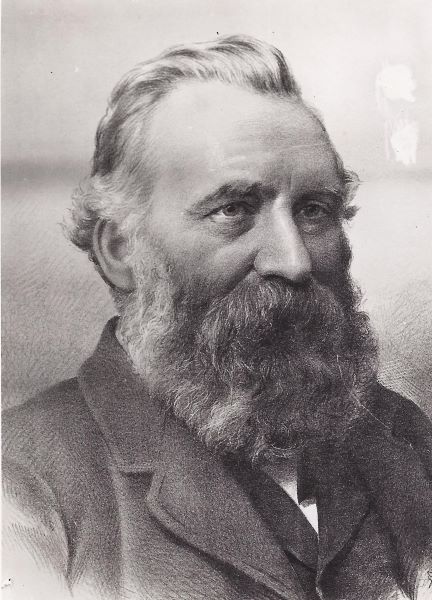

John Shanks
John Shanks
John Shanks (1826-1895) embodies the Victorian self-made man. From small beginnings, he built up what was to become the internationally-known company of Shanks and Co. Ltd. Described as having “definite originality in application” (1) and big ideas, much of the firm’s early success was due to the inventions and patents in sanitary ware that he developed.
As with many other businessmen of the era, John Shanks was also a public figure, involved in the community and in local church and political affairs. His nephew described him as “big-hearted and generous, ready to help others and to give to those who were in need” (2).
Beginnings
Around 1850, a contract to install a bell and clock in the Bourock Church tower in Barrhead was given to the joiner Abraham Bodys. He sub-let the plumbing and sheet metal contract to a young Paisley plumber named John Shanks. This appears to have been Shanks’ first Barrhead job, but it certainly wouldn’t be his last.
The son of William Shanks and Helen Gowens, John Shanks set up his plumbing business in Paisley in 1851, at the age of twenty-five. He had served an apprenticeship and some years as a skilled tradesman with Wallace & Connell, well-known plumbing contractors of the period. Seeing that there would be work for a plumber in a growing industrial town like Barrhead, two years later he opened a branch at Lowndes Street and then moved to the Main Street, opposite the Free Church. In a further two years, he closed his Paisley branch in favour of the Barrhead premises.

He was joined in the plumbing business after 1855 by his brother Andrew. They carried out their joint business in a workshop consisting of a plumber’s works on the ground floor, and a tinsmiths on the upper floor.
Meanwhile, Barrhead was changing, with the introduction of piped water from the Gorbals Waterworks during 1860-65, and a new sewage system a few years later. This meant that new houses had sinks with running water and a WC on each tenement landing. The demand for sanitary appliances was increasing and would continue to do so for the foreseeable future.
The key to Shanks’ success was that he was quick to appreciate the market potential of this growing awareness of public health. Around 1860 he had opened a brass foundry and finishing shop in the upper floor of his workshop, having decided to manufacture water closets.
Invention and innovation – building the business
Shanks set to work developing a water closet with a plunger valve and a ballcock to fill up the basin, for which he took out his first patent around 1864. Shanks’ nephew remembers being told that his uncle had had to pawn his gold watch to pay the patent fees. The design became known as the No. 4 and superceded the old pan closet. It became very popular all over the country. So successful was it, that John decided to build a new brass foundry to expand the business. This was done around 1866, and the new building became known as the Tubal Foundry. The name was seemingly suggested by his brother, a religious man, who took the name from Tubal Cain, the first artificer in brass and iron according to the Bible.
Business opportunities were available not only at home, but also at sea. In the 1860s, ships’ toilets had to be above the waterline in order to flush, which was inconvenient for the vessel’s general workings. Shanks took out a patent in 1865 for an under-waterline closet for use in ships and yachts. The design, which became known as No. 39, was excellent, and was fitted into many ships. It was the basis for the large shipping trade of Shanks and Co. Ltd and remained popular for many years to come.
By now John was the company’s innovator, having taken out around one hundred patents by 1894. However, his inventions and improvements were not always welcomed wholeheartedly. In The Annals of Barrhead, the author remembers a visitor to the town distributing leaflets which condemned the water closet as an ungodly innovation!
John was followed into the business by other family members over the years, as Shanks became known as clever inventors who patented many new processes. By the end of the century the firm occupied a seven-acre site and employed six hundred men.
Shanks the public man
John Shanks had several interests outside of the workshop and factory. He was a Conservative supporter until the Home Rule Bill, after which he became a Liberal Unionist. He was president of the Barrhead Evangelical Union and manager of the United Presbyterian Church. An active member of the temperance movement led by Reverend William Clark, he was elected to the first Neilston Parish Council in 1895, in the last year of his life.
He was married twice, to Isabella Mills and then Jessie Turnbull Smith. His son John followed him into the Shanks business when he was old enough to do so.
At his death on 18th December 1895, his share in the company was valued at £18,000. John Shanks did not forget his workers in his will: employees who had been with the company for six months on the day of his death were given an extra day’s pay.
“He foresaw great possibilities for the business, and if he – and the rest of us who were conducting the affairs in the early days – had had more knowledge of business, and more skill in manufacturing, his ideas would have been achieved at a much earlier date. However, to his courage and ingenuity is due much of the success that has already been achieved” (3). His nephew’s words are a fitting tribute to the erstwhile Paisley plumber with big ideas.
To find out more about Shanks & Co., visit our online exhibition Shanks & Co., 1851 – 1969
Shanks Collection
East Renfrewshire Heritage Service holds a significant collection of material on Shanks. You can search for it on our Heritage Catalogue and arrange to Visit Us to view it.
References
(1) Murray, Robert, Annals of Barrhead, Robert Gibson, 1942, p58.
(2) Shanks, Gilbert M., The First Hundred Years, 1851-1951, 1951, p6.
(3) Shanks, Gilbert M., ibid., p6.
Bibliography
Murray, Robert, Annals of Barrhead, Robert Gibson, 1942
McWhirter, James, Mine Ain Grey Toon
Shanks, Gilbert M, The First Hundred Years, 1851-1951
Collins, Patricia, John Shanks in Dictionary of Scottish Business Biography, Volume 2, Aberdeen University Press, 1990
